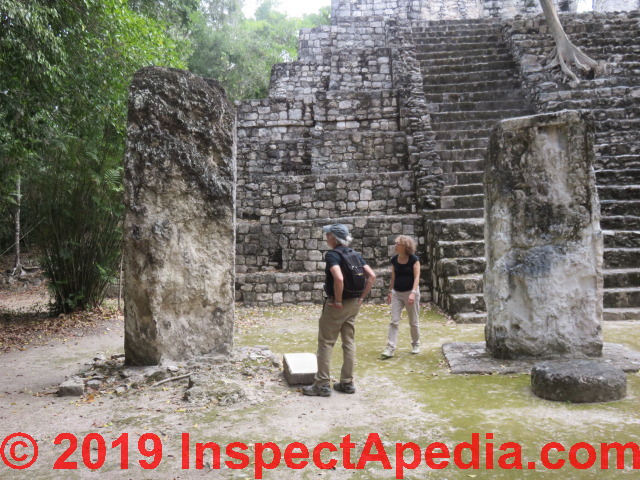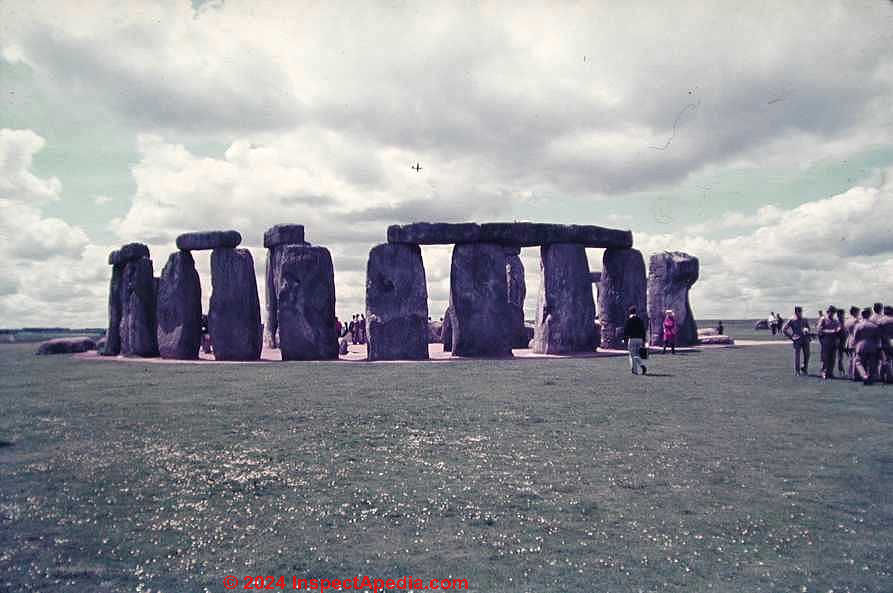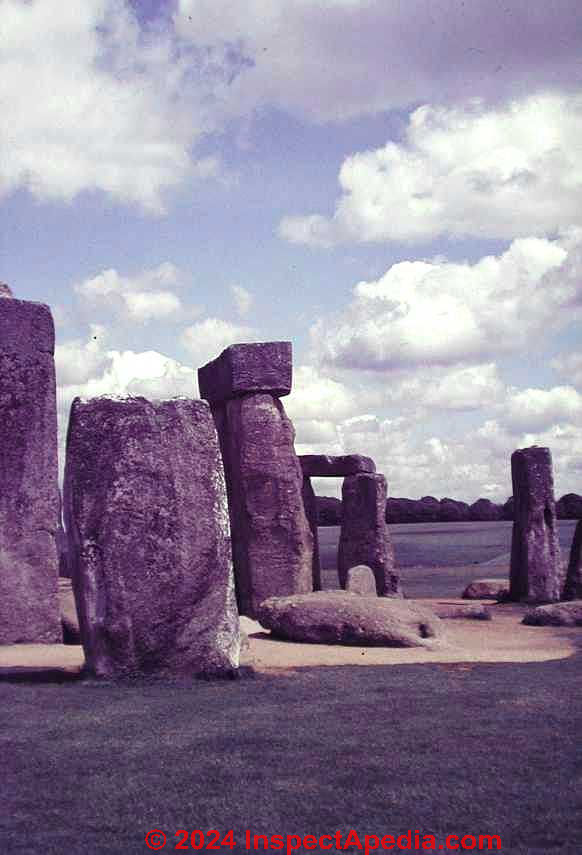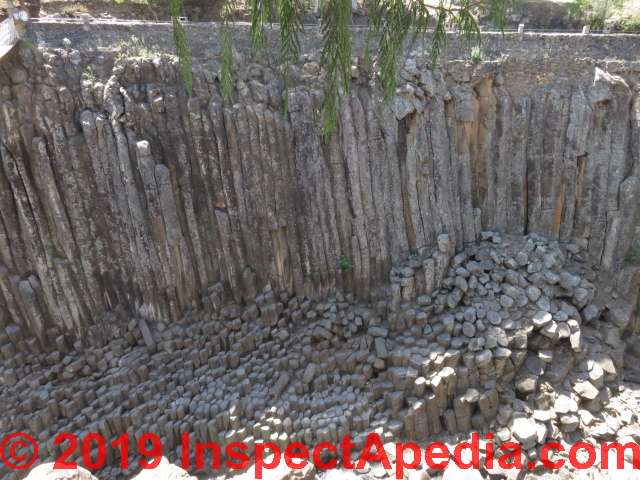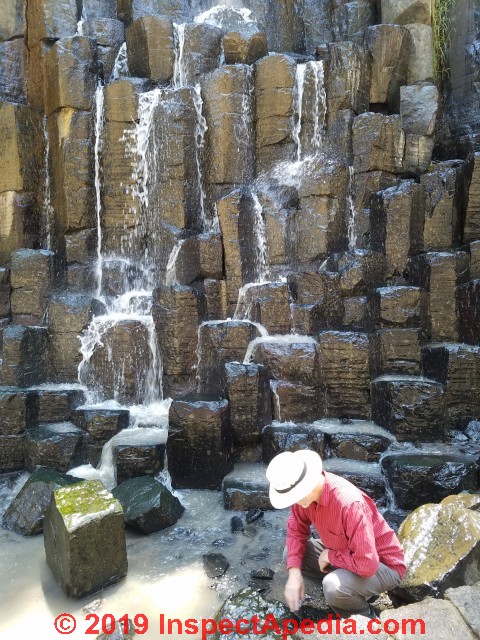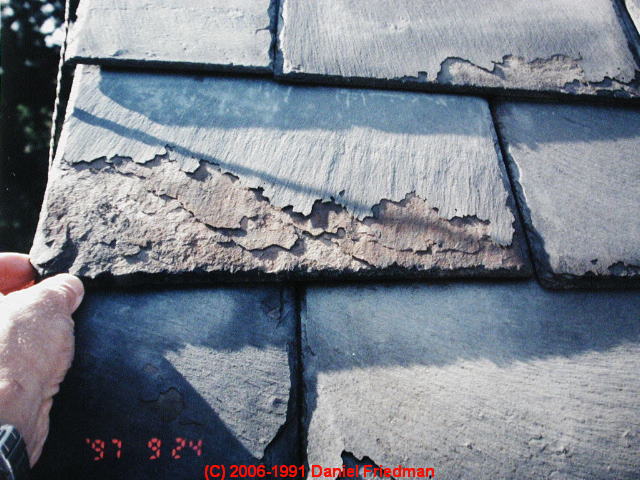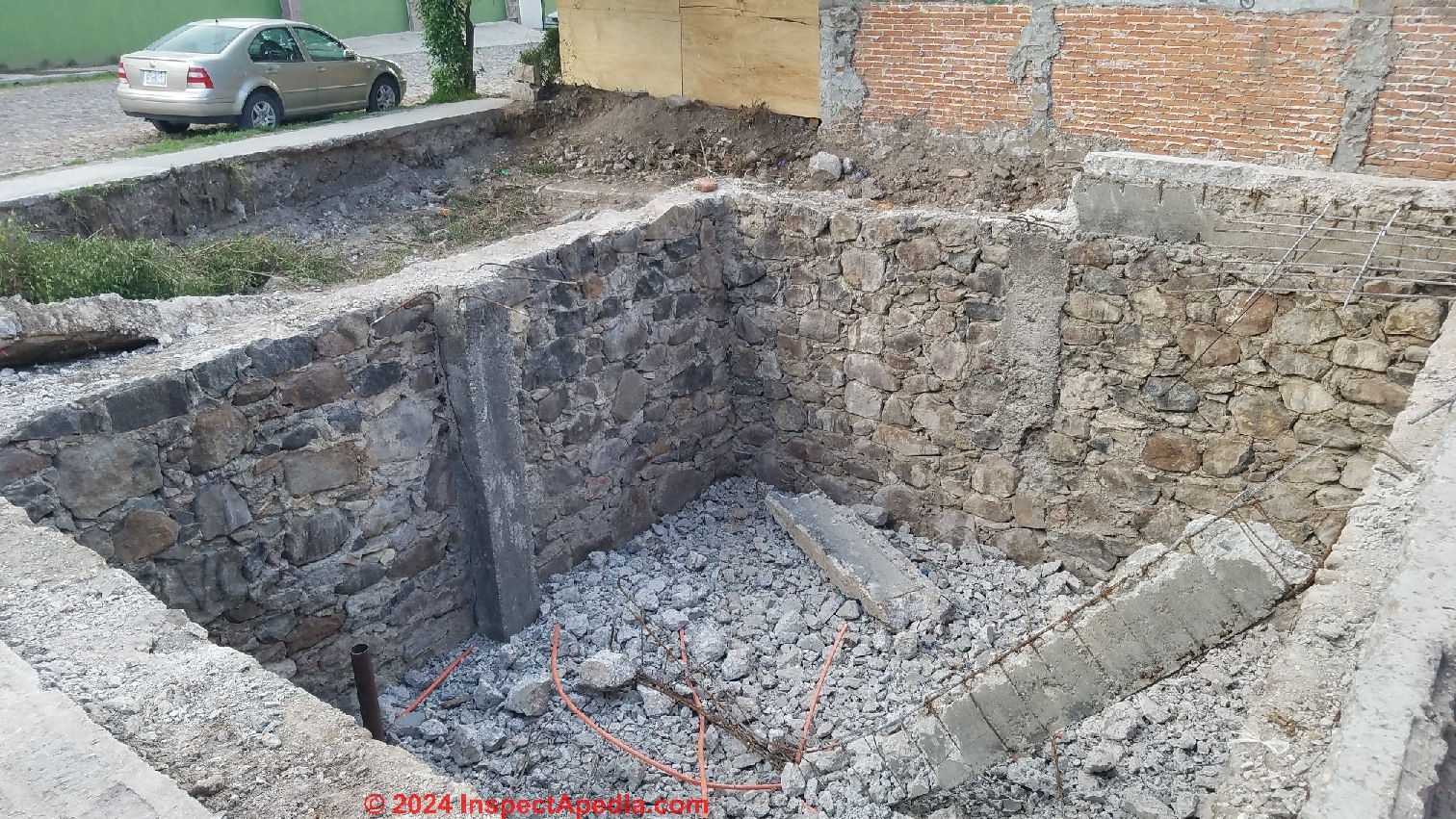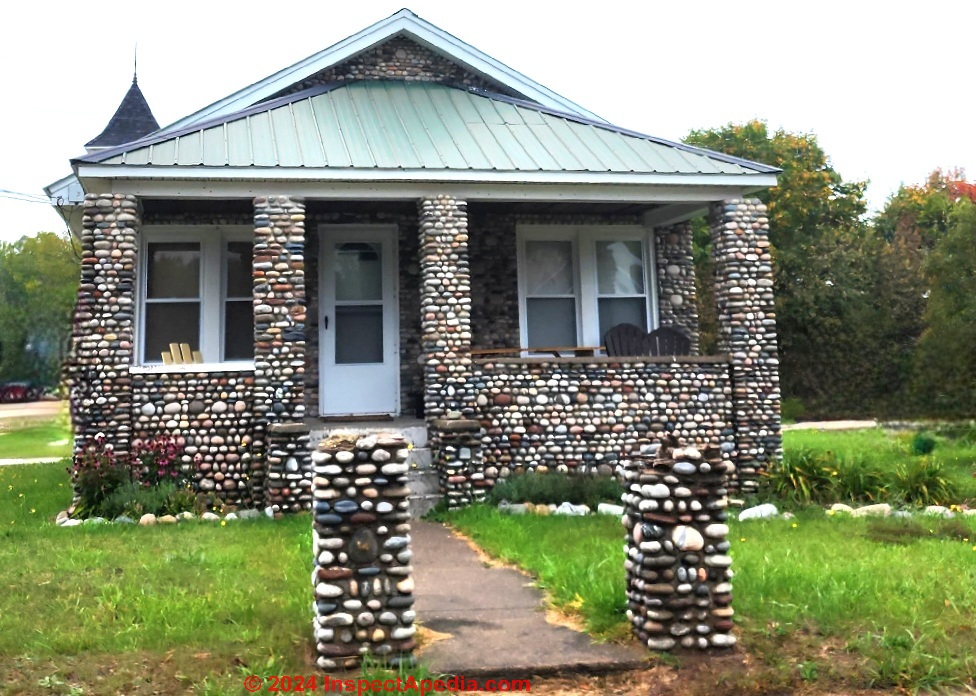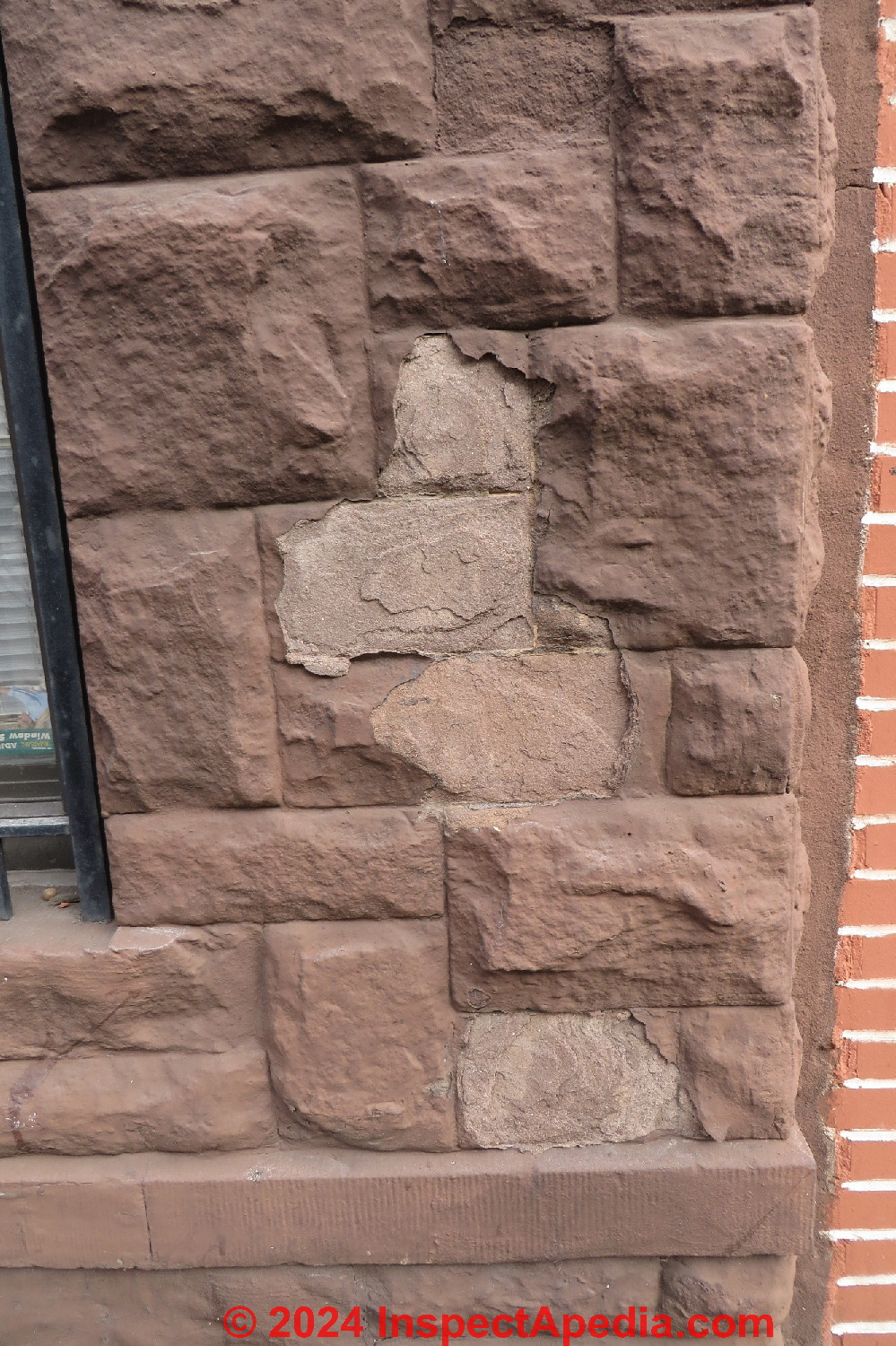 Types of Stone used in Foundations
Types of Stone used in Foundations
Descriptions of typical foundation stones
Which stones to use and which to avoid
- POST a QUESTION or COMMENT about types of stone used in stone foundations
This article describes the types of stone used in stone foundations and walls.
We explain the strengths and weaknesses of different types of stone and their relevant use in foundations and walls.
We define and name the different types of stone used in foundations, and we explain what drives the choice of which one to use, and we list most-popular foundation stones.
Some other stone types are not suitable for building foundations.
InspectAPedia tolerates no conflicts of interest. We have no relationship with advertisers, products, or services discussed at this website.
- Daniel Friedman, Publisher/Editor/Author - See WHO ARE WE?
Types of Stone Used in Building Foundations
Article Contents
- FOUNDATION STONE CHOICE: DRIVEN BY PROXIMITY
- BUILDING FOUNDATION STONE TYPES / NAMES
- POPULAR FOUNDATION STONES BY STONE SHAPE OR FORM
- SOFT FORMS OF STONE TO AVOID FOR FOUNDATIONS
Photo above: stone walls, pyramids and steles at Calakmul, Yucatan, Mexico. (Friedman)
The stone used at Calakmul in Mexico was a soft limestone, mined nearby. Limestone is comparatively soft which explains why some of the monoliths in our photo are so worn as to have lost inscriptions and images.
...
Foundation Stone Choice: Driven by Proximity
In most parts of the world builders used whatever reasonably-hard stone was closest to the job site, since transportation cost is a significant factor.
But on occasion stones were moved from afar.
The bluestones used to construct the monolithics at Stonehenge (ca 1900 B.C.E.) are an igneous stone from the Preseli Hills over 225 kilometers (about 140 miles) away in western Wales.
The Stonehenge photos above and below are by Friedman and were taken in 1972.
Some of the authors whose work on the history of Stonehenge that we reviewed think that the stones were floated down the Avon river to get them to the Stonehenge site in the Salisbury Plain in Wiltshire, England.
So while it's true that sometimes special stones were transported great distances, usually stone structures used locally available stone for the obvious reason that stone is heavy and troublesome to transport. We make best use of what's close-by.
...
Building Foundation Stone Types / Names
Of the 3 broad classes of stone, igneous, metamorphic and sedimentary, the first two make best foundation material but some sedimentary stone too may be hard and stable enough to use.
Photo: the Balsatic Prisms of Santa Maria Regla, near Husaca de Ocampo, las prismas balsaticas in Hidalgo, Mexico, photographed by the author in April 2018.
These basaltic canyon walls are lined by tall vertical 5-sided or 6-sided polygons of basalt that range in height from just a few feet (at the canyon bottom) to 164 Sfeet high above the water level.
Popular for centuries among Mexican peoples the canyon was promoted among Europeans and tourists from the north following a visit to the site by German geographer Alexander von Humboldt in 1803.
Below our second photo gives a closer look at the pentagonal and hexagonal layered basalt columns while the author [DF] provides a reference of scale.
Popular types of stone used for foundation use include
- Basalt -
(our favorite) is a very dark / black fine-grained volcanic rock, sometimes formed in a columnar structure.
Photo above: a closer look at the geometric form of the Balsatic Prisms of Santa Maria Regla.
- Gneiss -
a "high grade" metamorphic rock that is banded, layered, or "foiliated" in structure, coarse-grained, principally made up of feldspar, quartz, and mica. - Granite -
a very hard granular, crystalline igneous rock widely used in building construction - Laterite
stone is formed by the weathering of igneous rocks in moist warm climates, or a clay-soil high in aluminum oxide and iron.
- Limestone
(depending on the quality and hardness) - limestone is a hard sedimentary rock, principally Dolomite or Calcium Carbonate.
Also see our discussion of cleaning stains from limestone at
STONE, STUCCO & BRICK CLEANING METHODS - Marble
another metamorpiic rock, is metamorphosed limestone or dolomite, both of which contain a high concentration of calcium carbonate (CaCO3).
Marble is rarely as a building foundation or wall stone except where construction is close to marble quarries - Quartzite -
a very hard granular rock, possibly silicified or metamorphosed sandstone (Sarsen stones).
Photo above: deteriorating brownstone on a building in Brooklyn, New York.
Below, a more durable brownstone building behind the Alexander Pollock family and the author's previoius wife Harriet in Edinburgh, Scotland in 1972. (Mr. Pollock, a former Scottish Conservative Party politician was a young barrister when the author took this photo.)
- Sandstone & Brownstone
a sedimentary rock formed by sand (quartz) grains cemented together, typically red, yellow or brown in color; Brownstone may also be used in foundations depending on quality, hardness, stability of the particular stone and its source quarry.
Brownstone, a reddish brown stone (thanks to the presence of iron oxide (FeO2) has been popular for building facades, lintels, steps, is a type of sandstone.
See also STAINS on SANDSTONE, DIAGNOSE & CURE
See also MASONRY FACADE / WALL, LINTEL & BROWNSTONE DAMAGE - Schist -
a medium-grade metamorphic rock, harder than slate, softer than granite or gneiss.
- Slate
"stone" is a fine-grained metamorphic rock with perfect cleavage. It's that cleavage that allows slate to be split into thin layers widely used as roofing, or in thicker forms as walks. Slate as a building wall or foundation material is not common, again depending on hardness and stability and resistance to fracturing.
See also SLATE ROOF COLORS & SLATE CHEMISTRY - Trap stone -
any dark igneous rock crushed to random shapes - Travertine stone -
stone formed in hot springs and/or limestone caves, similar to marble, granite, onyx, limestone, slage (thanks to travertinewarehouse.com )
...
Popular foundation stones by stone shape or form

Photo above: this fieldstone foundation at a pre-1900 New York home was leaky and damaged enough that a previous building owner had begun constructing a concrete block inner "wall" to help stabilize the structure.
Notice that the fieldstone is uncut / unfinished, and that it is two or more feet in thickness.
- Fieldstone
unfinished stone that is used in its natural form as found in nature, typically from arable or pasture land, in piles also called "clearance cairns".
Photo above: a quarry stone foundation in San Miguel de Allende, Mexico. These stones have been rough-finished on at least one side to give a flat surface.
- Quarry stone -
stone removed from an open pit mine, excavated, usually finished on one or more sides.
Some quarry stones of particular properties or from a specific location take their name from the quarry, such as bath stone.
Bath stone is an oolitic limestone formed 195 to 135 million years ago during the Jurassic period and mined in Bath in Somerset England, the U.K. (Bath is so named for its Roman-constructed baths).
Photo above: a river stone house photoraphed by DF in Germfask, Michigan in 2023.
- River stone -
stones of various types found in a riverbed, typically smoothed by the action of water and movement of other stones and abrasives carried by water.
The popularity of a stone type may depend on the form in which it will be used. Stone may be used in construction of building foundations or walls in these shapes or forms:
- its natural form or shape
- rubble
- rounded
- worked into squared faces or into just one or two squared faces.
...
Soft Forms of Stone to Avoid for Foundations
What people would avoid (but you may still find) would include softer stones or stones that fracture or cleave easily, such as
SOFTER forms of
- sandstone
- brownstone
- slate
...
Continue reading at STONE FOUNDATION DEFECTS or select a topic from the closely-related articles below, or see the complete ARTICLE INDEX.
Or see these
Recommended Articles
- BULGED vs. LEANING FOUNDATIONS
- BULGE or LEAN MEASUREMENTS
- FOUNDATION DAMAGE REPORTS
- FOUNDATION DAMAGE by ICE LENSING
- FOUNDATION DAMAGE by MATERIAL or INCLUSIONS
- FOUNDATION DAMAGE SEVERITY
- FOUNDATION FAILURES in CLAY SOIL
- FOUNDATION FAILURE by INSULATION - insulation causing foundation buckling or damage
- FOUNDATION FAILURES by MOVEMENT TYPE - home
- FOUNDATION FAILURES by TYPE & MATERIAL - home
- FOUNDATION INSPECTION METHODS
- FROST HEAVES, FOUNDATION, SLAB
- HORIZONTAL MOVEMENT IN FOUNDATIONS
- INSULATION LOCATION - WHERE TO PUT IT - home & separate article series
- STONE FOUNDATION DEFECTS
- STRUCTURAL COLLAPSE HAZARDS
- VERTICAL MOVEMENT IN FOUNDATIONS
Suggested citation for this web page
STONE FOUNDATION - TYPES OF STONE USED at InspectApedia.com - online encyclopedia of building & environmental inspection, testing, diagnosis, repair, & problem prevention advice.
Or see this
INDEX to RELATED ARTICLES: ARTICLE INDEX to BUILDING STRUCTURES
Or use the SEARCH BOX found below to Ask a Question or Search InspectApedia
Ask a Question or Search InspectApedia
Questions & answers or comments about stone foundations..
Try the search box just below, or if you prefer, post a question or comment in the Comments box below and we will respond promptly.
Search the InspectApedia website
Note: appearance of your Comment below may be delayed: if your comment contains an image, photograph, web link, or text that looks to the software as if it might be a web link, your posting will appear after it has been approved by a moderator. Apologies for the delay.
Only one image can be added per comment but you can post as many comments, and therefore images, as you like.
You will not receive a notification when a response to your question has been posted.
Please bookmark this page to make it easy for you to check back for our response.
IF above you see "Comment Form is loading comments..." then COMMENT BOX - countable.ca / bawkbox.com IS NOT WORKING.
In any case you are welcome to send an email directly to us at InspectApedia.com at editor@inspectApedia.com
We'll reply to you directly. Please help us help you by noting, in your email, the URL of the InspectApedia page where you wanted to comment.
Citations & References
In addition to any citations in the article above, a full list is available on request.
- David Grudzinski, Advantage Home Inspections,
ASHI cert # 249089, HUD cert# H-145, is a professional home inspector who contributes on various topics including structural matters.
David Grudzinski, Cranston RI serving both Rhode Island and Eastern Connecticut can be reached at 401-935-6547 fax- 401-490-0607 or by email to Davidgrudzinski@aol.com - Mark Cramer Inspection Services Mark Cramer, Tampa Florida, Mr. Cramer is a past president of ASHI, the American Society of Home Inspectors and is a Florida home inspector and home inspection educator. Mr. Cramer serves on the ASHI Home Inspection Standards. Contact Mark Cramer at: 727-595-4211 mark@BestTampaInspector.com
- John Cranor [Website: /www.house-whisperer.com ] is an ASHI member and a home inspector (The House Whisperer) is located in Glen Allen, VA 23060. He is also a contributor to InspectApedia.com in several technical areas such as plumbing and appliances (dryer vents). Contact Mr. Cranor at 804-873-8534 or by Email: johncranor@verizon.net
- "Concrete Slab Finishes and the Use of the F-number System", Matthew Stuart, P.E., S.E., F.ASCE, online course at www.pdhonline.org/courses/s130/s130.htm
- Sal Alfano - Editor, Journal of Light Construction*
- Thanks to Alan Carson, Carson Dunlop, Associates, Toronto, for technical critique and some of the foundation inspection photographs cited in these articles
- Terry Carson - ASHI
- Mark Cramer - ASHI
- JD Grewell, ASHI
- Duncan Hannay - ASHI, P.E. *
- Bob Klewitz, M.S.C.E., P.E. - ASHI
- Ken Kruger, P.E., AIA - ASHI
- Aaron Kuertz aaronk@appliedtechnologies.com, with Applied Technologies regarding polyurethane foam sealant as other foundation crack repair product - 05/30/2007
- Bob Peterson, Magnum Piering - 800-771-7437 - FL*
- Arlene Puentes, ASHI, October Home Inspections - (845) 216-7833 - Kingston NY
- Greg Robi, Magnum Piering - 800-822-7437 - National*
- Dave Rathbun, P.E. - Geotech Engineering - 904-622-2424 FL*
- Ed Seaquist, P.E., SIE Assoc. - 301-269-1450 - National
- Dave Wickersheimer, P.E. R.A. - IL, professor, school of structures division, UIUC - University of Illinois at Urbana-Champaign School of Architecture. Professor Wickersheimer specializes in structural failure investigation and repair for wood and masonry construction. * Mr. Wickersheimer's engineering consulting service can be contacted at HDC Wickersheimer Engineering Services. (3/2010)
- *These reviewers have not returned comment 6/95
- Masonry structures: The Masonry House, Home Inspection of a Masonry Building & Systems, Stephen Showalter (director, actor), DVD, Quoting:
Movie Guide Experienced home inspectors and new home inspectors alike are sure to learn invaluable tips in this release designed to take viewers step-by-step through the home inspection process. In addition to being the former president of the National Association of Home Inspectors (NAHI), a longstanding member of the NAHI, the American Society of Home Inspectors (ASHI), and the Environmental Standard Organization (IESO), host Stephen Showalter has performed over 8000 building inspections - including environmental assessments. Now, the founder of a national home inspection school and inspection training curriculum shares his extensive experience in the inspection industry with everyday viewers looking to learn more about the process of evaluating homes. Topics covered in this release include: evaluation of masonry walls; detection of spalling from rebar failure; inspection of air conditioning systems; grounds and landscaping; electric systems and panel; plumbing supply and distribution; plumbing fixtures; electric furnaces; appliances; evaluation of electric water heaters; and safety techniques. Jason Buchanan --Jason Buchanan, All Movie Review - Building Pathology, Deterioration, Diagnostics, and Intervention, Samuel Y. Harris, P.E., AIA, Esq., ISBN 0-471-33172-4, John Wiley & Sons, 2001 [General building science-DF] ISBN-10: 0471331724 ISBN-13: 978-0471331728
- Building Pathology: Principles and Practice, David Watt, Wiley-Blackwell; 2 edition (March 7, 2008) ISBN-10: 1405161035 ISBN-13: 978-1405161039
- CRAWL SPACE MOISTURE CONTROL [PDF] U.S. Department of Energy
- Diagnosing & Repairing House Structure Problems, Edgar O. Seaquist, McGraw Hill, 1980 ISBN 0-07-056013-7 (obsolete, incomplete, missing most diagnosis steps, but very good reading; out of print but used copies are available at Amazon.com, and reprints are available from some inspection tool suppliers). Ed Seaquist was among the first speakers invited to a series of educational conferences organized by D Friedman for ASHI, the American Society of Home Inspectors, where the topic of inspecting the in-service condition of building structures was first addressed.
- Building Failures, Diagnosis & Avoidance, 2d Ed., W.H. Ransom, E.& F. Spon, New York, 1987 ISBN 0-419-14270-3
- Guide to Domestic Building Surveys, Jack Bower, Butterworth Architecture, London, 1988, ISBN 0-408-50000 X
- "Avoiding Foundation Failures," Robert Marshall, Journal of Light Construction, July, 1996 (Highly recommend this article-DF)
- "A Foundation for Unstable Soils," Harris Hyman, P.E., Journal of Light Construction, May 1995
- "Backfilling Basics," Buck Bartley, Journal of Light Construction, October 1994
- In addition to citations & references found in this article, see the research citations given at the end of the related articles found at our suggested
CONTINUE READING or RECOMMENDED ARTICLES.
- Carson, Dunlop & Associates Ltd., 120 Carlton Street Suite 407, Toronto ON M5A 4K2. Tel: (416) 964-9415 1-800-268-7070 Email: info@carsondunlop.com. Alan Carson is a past president of ASHI, the American Society of Home Inspectors.
Thanks to Alan Carson and Bob Dunlop, for permission for InspectAPedia to use text excerpts from The HOME REFERENCE BOOK - the Encyclopedia of Homes and to use illustrations from The ILLUSTRATED HOME .
Carson Dunlop Associates provides extensive home inspection education and report writing material. In gratitude we provide links to tsome Carson Dunlop Associates products and services.


